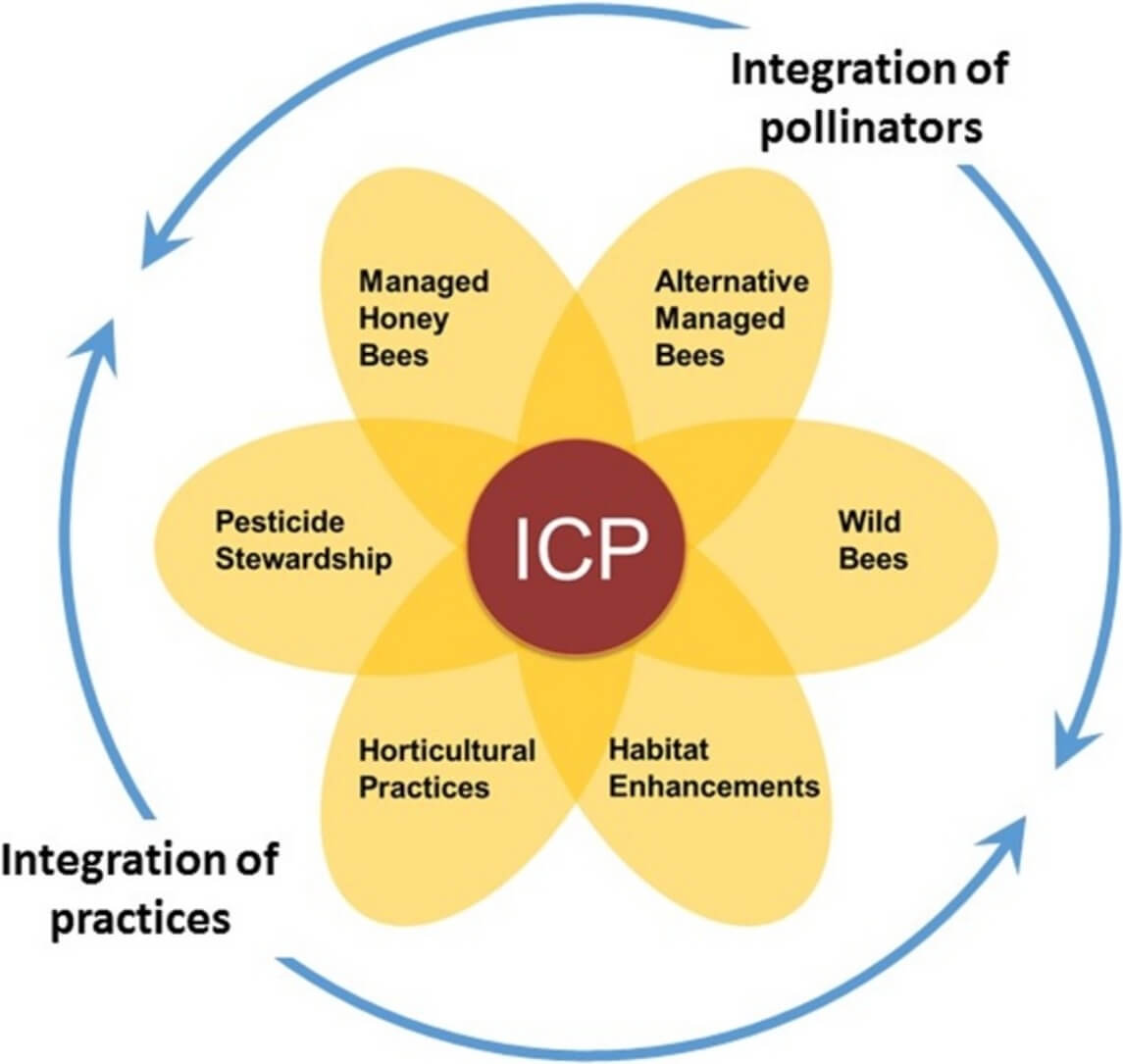As the world’s dependence on pollinators increases, researchers from around the country work to develop practical strategies to ensure that our nation’s crops are adequately pollinated.
In a collaboration between nearly a dozen universities and institutions, including the University of Florida Honey Bee Research and Extension Lab, research on the newly-coined concept of “Integrated Crop Pollination” (ICP) spanned the last five years, at least six states (plus British Columbia), and seven cropping systems. Two recently published works discuss the research completed on this project as well as the framework for what ICP means. These works are summarized in brief below. For further details, read the Guide to Integrated Crop Pollination or Integrated Crop Pollination: Combining strategies to ensure stable and sustainable yields of pollination-dependent crops.
What is Integrated Crop Pollination?
To better understand Integrated Crop Pollination (ICP), it is best to first start with a perhaps more familiar concept: Integrated Pest Management, or IPM.

What IPM is for agricultural pest control, ICP is for crop pollination. Both concepts work to solve a problem (pest damage and inadequate pollination, respectively) by looking to variety of solutions that, when combined appropriately, can be highly effective. The combination of multiple practices into one cropping system are integral to both concepts. While IPM seeks to reduce pests through mechanical, cultural, biological, and chemical means, ICP seeks to increase crop pollination through the combined efforts of grower practices, and the use of managed and wild bees.
In a recently published paper, researchers define the concept of Integrated Crop Pollination as:
“The use of managed pollinator species in combination with farm management practices that support, augment, and protect pollinator populations to provide reliable and economical pollination of crops.”
Integrating Pollinators
The concept of ICP considers how to choose the best combination of pollinators to give growers the highest return on investment. This return is manifested in receiving adequate pollination to maximize fruit set, or amount of crop harvested. ICP recognizes three main pollinator groups that growers can turn to:
- Managed honey bees
- Alternative managed bees
- Wild bees

The ICP framework simultaneously, “recognizes the essential role of honey bees as specialty crop pollinators” and acknowledges the potential for other managed bee species (bumble bees, alfalfa leafcutter bees, etc.) and wild bees to contribute to reliable crop pollination. In many cases, honey bees alone provide adequate pollination; other times (as is the case on some small vegetable farms in the Mid-Atlantic United States) wild populations of bees are enough to provide a good harvest. In many cases the combination of managed honey bee colonies and alternative species of wild or managed bees can be the most economical option for growers. In fact, in some cropping systems, the presence of some wild bee species actually increases the overall effectiveness of the managed honey bees on that field.
On-farm Practices
Maintaining or establishing areas around farms can provide additional floral resources to wild and managed bees, which may lead to increased crop pollination and greater nutritional diversity for bees. The goals of these pollinator habitats include the following:
- Enhancing pollination
- Enhancing other ecosystem services (for example, beneficial insects that prey upon crop pests)
- Minimizing crop pests that could potentially benefit from additional habitat
- Minimizing the pulling of bees from their target crop
- Maximizing cost effectiveness
Furthermore, good pesticide stewardship by growers goes a long way in protecting and enhancing pollinators on farm landscapes. Common Integrated Pest Management practices can lead to the decreased use of pesticides on fields and can limit managed and wild bees’ exposure to these pesticides. On top of these measures, growers can and often do take additional steps to protect managed and wild bees. For details on these steps, check out the UF Bee Lab document, Minimizing Honey Bee Exposure to Pesticides. To read up on IPM practices, check out this University of California extension document: What is Integrated Pest Management?
The most effective combinations of practices and pollinators will vary between crops and regions. Regardless, considering crop pollination from this integrated approach can benefit both growers and bees alike. Continued research on ICP in specific cropping systems will provide more insight into ways to improve the pollination of specialty crops across the U.S.
To learn more about Integrated Crop Pollination, visit www.icpbees.org, read the Guide to Integrated Crop Pollination, or read the research: Integrated Crop Pollination: Combining strategies to ensure stable and sustainable yields of pollination-dependent crops.
Have something to say? Join the conversation on Facebook or Twitter.
 0
0

